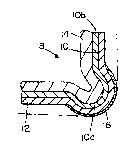Une partie des informations de ce site Web a été fournie par des sources externes. Le gouvernement du Canada n'assume aucune responsabilité concernant la précision, l'actualité ou la fiabilité des informations fournies par les sources externes. Les utilisateurs qui désirent employer cette information devraient consulter directement la source des informations. Le contenu fourni par les sources externes n'est pas assujetti aux exigences sur les langues officielles, la protection des renseignements personnels et l'accessibilité.
L'apparition de différences dans le texte et l'image des Revendications et de l'Abrégé dépend du moment auquel le document est publié. Les textes des Revendications et de l'Abrégé sont affichés :
| (12) Brevet: | (11) CA 2022719 |
|---|---|
| (54) Titre français: | BAGUETTE D'ANGLE POUR CONSTRUCTION A MURS SECS |
| (54) Titre anglais: | CORNER BEAD FOR DRYWALL CONSTRUCTION |
| Statut: | Durée expirée - au-delà du délai suivant l'octroi |
| (51) Classification internationale des brevets (CIB): |
|
|---|---|
| (72) Inventeurs : |
|
| (73) Titulaires : |
|
| (71) Demandeurs : |
|
| (74) Agent: | OYEN WIGGS GREEN & MUTALA LLP |
| (74) Co-agent: | |
| (45) Délivré: | 1994-04-26 |
| (22) Date de dépôt: | 1990-08-03 |
| (41) Mise à la disponibilité du public: | 1991-12-22 |
| Requête d'examen: | 1991-03-15 |
| Licence disponible: | S.O. |
| Cédé au domaine public: | S.O. |
| (25) Langue des documents déposés: | Anglais |
| Traité de coopération en matière de brevets (PCT): | Non |
|---|
| (30) Données de priorité de la demande: | ||||||
|---|---|---|---|---|---|---|
|
IMPROVED CORNER BEAD FOR DRYWALL CONSTRUCTION
Abstract of the Disclosure
A corner bead for drywall construction has a
galvanized steel core strip which is formed with a central
portion, side flanges, and shoulders joining the central
portion and side flanges. The front face of the core strip is
covered with a paper layer having an outer protective coating
thereon overlying the central portion adjoining said
shoulders. A paper reinforcing layer covers the back of the
core strip to minimize the thickness of the core strip.
Note : Les revendications sont présentées dans la langue officielle dans laquelle elles ont été soumises.
Note : Les descriptions sont présentées dans la langue officielle dans laquelle elles ont été soumises.

2024-08-01 : Dans le cadre de la transition vers les Brevets de nouvelle génération (BNG), la base de données sur les brevets canadiens (BDBC) contient désormais un Historique d'événement plus détaillé, qui reproduit le Journal des événements de notre nouvelle solution interne.
Veuillez noter que les événements débutant par « Inactive : » se réfèrent à des événements qui ne sont plus utilisés dans notre nouvelle solution interne.
Pour une meilleure compréhension de l'état de la demande ou brevet qui figure sur cette page, la rubrique Mise en garde , et les descriptions de Brevet , Historique d'événement , Taxes périodiques et Historique des paiements devraient être consultées.
| Description | Date |
|---|---|
| Inactive : Périmé (brevet - nouvelle loi) | 2010-08-03 |
| Inactive : Lettre officielle | 2007-03-15 |
| Inactive : Paiement correctif - art.78.6 Loi | 2007-01-26 |
| Inactive : Lettre officielle | 2006-05-26 |
| Inactive : Lettre officielle | 2006-03-31 |
| Inactive : CIB de MCD | 2006-03-11 |
| Inactive : Renversement de l'état réputé périmé | 2006-03-09 |
| Inactive : Demande ad hoc documentée | 2006-02-24 |
| Lettre envoyée | 2000-08-11 |
| Lettre envoyée | 2000-08-11 |
| Accordé par délivrance | 1994-04-26 |
| Demande publiée (accessible au public) | 1991-12-22 |
| Toutes les exigences pour l'examen - jugée conforme | 1991-03-15 |
| Exigences pour une requête d'examen - jugée conforme | 1991-03-15 |
Il n'y a pas d'historique d'abandonnement
| Type de taxes | Anniversaire | Échéance | Date payée |
|---|---|---|---|
| TM (brevet, 7e anniv.) - générale | 1997-08-04 | 1997-07-16 | |
| TM (brevet, 8e anniv.) - générale | 1998-08-03 | 1998-07-15 | |
| TM (brevet, 9e anniv.) - générale | 1999-08-03 | 1999-07-20 | |
| TM (brevet, 11e anniv.) - générale | 2001-08-03 | 2001-07-19 | |
| TM (brevet, 12e anniv.) - générale | 2002-08-05 | 2002-07-18 | |
| TM (brevet, 13e anniv.) - générale | 2003-08-04 | 2003-07-21 | |
| TM (brevet, 14e anniv.) - générale | 2004-08-03 | 2004-07-21 | |
| TM (brevet, 15e anniv.) - générale | 2005-08-03 | 2005-07-20 | |
| TM (brevet, 16e anniv.) - générale | 2006-08-03 | 2006-07-17 | |
| 2007-01-26 | |||
| TM (brevet, 17e anniv.) - générale | 2007-08-03 | 2007-07-25 | |
| TM (brevet, 18e anniv.) - générale | 2008-08-04 | 2008-07-17 | |
| TM (brevet, 19e anniv.) - générale | 2009-08-03 | 2009-07-21 |
Les titulaires actuels et antérieures au dossier sont affichés en ordre alphabétique.
| Titulaires actuels au dossier |
|---|
| BEADEX MANUFACTURING COMPANY, INC. |
| Titulaires antérieures au dossier |
|---|
| DON EVAN KING |
| JAMES ARTHUR RITCHIE |